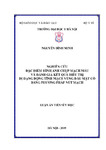
Please use this identifier to cite or link to this item:
http://dulieuso.hmu.edu.vn/handle/hmu/1944| Title: | Nghiên cứu đặc điểm hình ảnh chụp mạch máu và đánh giá kết quả điều trị dị dạng động tĩnh mạch vùng đầu mặt cổ bằng phương pháp nút mạch |
| Authors: | Nguyễn Đình, Minh |
| Advisor: | PGS.TSKH. Nguyễn Đình, Tuấn |
| Keywords: | 62720165;Chẩn đoán hình ảnh |
| Abstract: | Những kết luận mới của luận án:. - Trên hình ảnh chụp mạch máu, số lượng động mạch (ĐM) cấp máu trung bình cho DDĐTM-ĐMC là 3,8±2,28 ĐM, nhiều nhất là 10 ĐM, hay gặp nhất là ĐM thái dương nông với 56% bên phải và 52% bên trái. Số lượng tĩnh mạch (TM) dẫn lưu trung bình là 1,9±0,97 TM, nhiều nhất là 5 TM, hay gặp nhất là TM thái dương nông, với 32% bên phải và 26% bên trái. Phân loại Cho III là hay gặp nhất, chiếm 80% trường hợp, trong đó 95,7% loại này được phát hiện từ nhỏ và 94,7% tăng trưởng mạnh trong thời kỳ như dậy thì hoặc có thai. Phân loại Cho I và II có liên quan đến chấn thương.. - Kết quả nút mạch DDĐTM-ĐMC cho thấy phân loại Cho I và II có tỷ lệ tắc mạch cao hơn loại III. Kích thước <5cm có tỷ lệ tắc mạch hoàn toàn cao nhất là 71,4%, có 88% BN chảy máu <100ml trong mổ. Khả năng PT lấy bỏ hoàn toàn liên quan đến kích thước <5cm, khu trú trong 1 vùng giải phẫu và phân loại Cho I và II theo tỷ lệ tương ứng là 100%, 82,8% và 100%. Theo dõi sau điều trị 35,5±26,84 tháng thấy 81,6% BN giảm GĐLS theo Schobinger. Tỷ lệ khỏi bệnh hoàn toàn là 47,4%. Hiệu quả điều trị bao gồm bệnh khỏi và đỡ là 92,1%, trong đó nhóm nút mạch và phẫu thuật là 93,7% và nhóm nút mạch không phẫu thuật là 83,4%. Các yếu tố liên quan đến tỷ lệ khỏi bệnh là nam giới (63,6%), phân loại Cho I và II (88,9%), nút bằng chọc trực tiếp (83,3%) và tắc mạch hoàn toàn sau nút (66,7%).. New contribution of the thesis:. - On angiography, average number of feeding arteries of head and neck arteriovenous malformations was 3,8±2,28 ĐM, the highest was 10 feeding arteries, the superficial temporal artery was the most common with 56% on the right side and 52% on the left. Average number of draining veins was 1,9±0,97, the highest was 5 veins, the superficial temporal vein was the most common with 32% on the right side and 26% on the left. Cho’s type III was more common with 80% cases, in which 95,7% this type was found at child age and 94,7% developing in andolescent or pregnant periods. Cho’s type I&II was related to injuries.. - The study results showed that Cho’s type I&II had higher occlusion rate than Cho’s type III. The lesions <5cm had the highest incidence of complete occlusion with 71,4%; 88% cases bleeding under 100ml in surgery. The abilities of total excision is closely related to factors such as lesion size < 5cm, extent in one anatomical location and Cho’s type I&II with 100%, 82,8% and 100%, respectively. Folow up 35,5±26,84 months show that Schobinger’s grade was reduced in 81,6%, 47,4% patients achieved complete improvement. The treament effect including “complete improvement” and “partial improvement” was 92,1%, in which 93,7% using embolisation combining with surgery and 83,4% by embolisation standalone. The factors directly linked to “complete improvement” were male (63,6%), Cho’s type I&II (88,9%), direct punction embolisation (83,3%) and complete occlusion after embolisation (66,7%).. |
| URI: | http://dulieuso.hmu.edu.vn//handle/hmu/1944 |
| Appears in Collections: | Luận án (nghiên cứu sinh) |
Files in This Item:
| File | Description | Size | Format | |
|---|---|---|---|---|
| 467_TVLA NGUYENDINHMINH.pdf Restricted Access | 4.48 MB | Adobe PDF |  Sign in to read | |
| 467_TTLA NguyenDinhMinh.pdf Restricted Access | 714.47 kB | Adobe PDF |  Sign in to read |
Items in DSpace are protected by copyright, with all rights reserved, unless otherwise indicated.